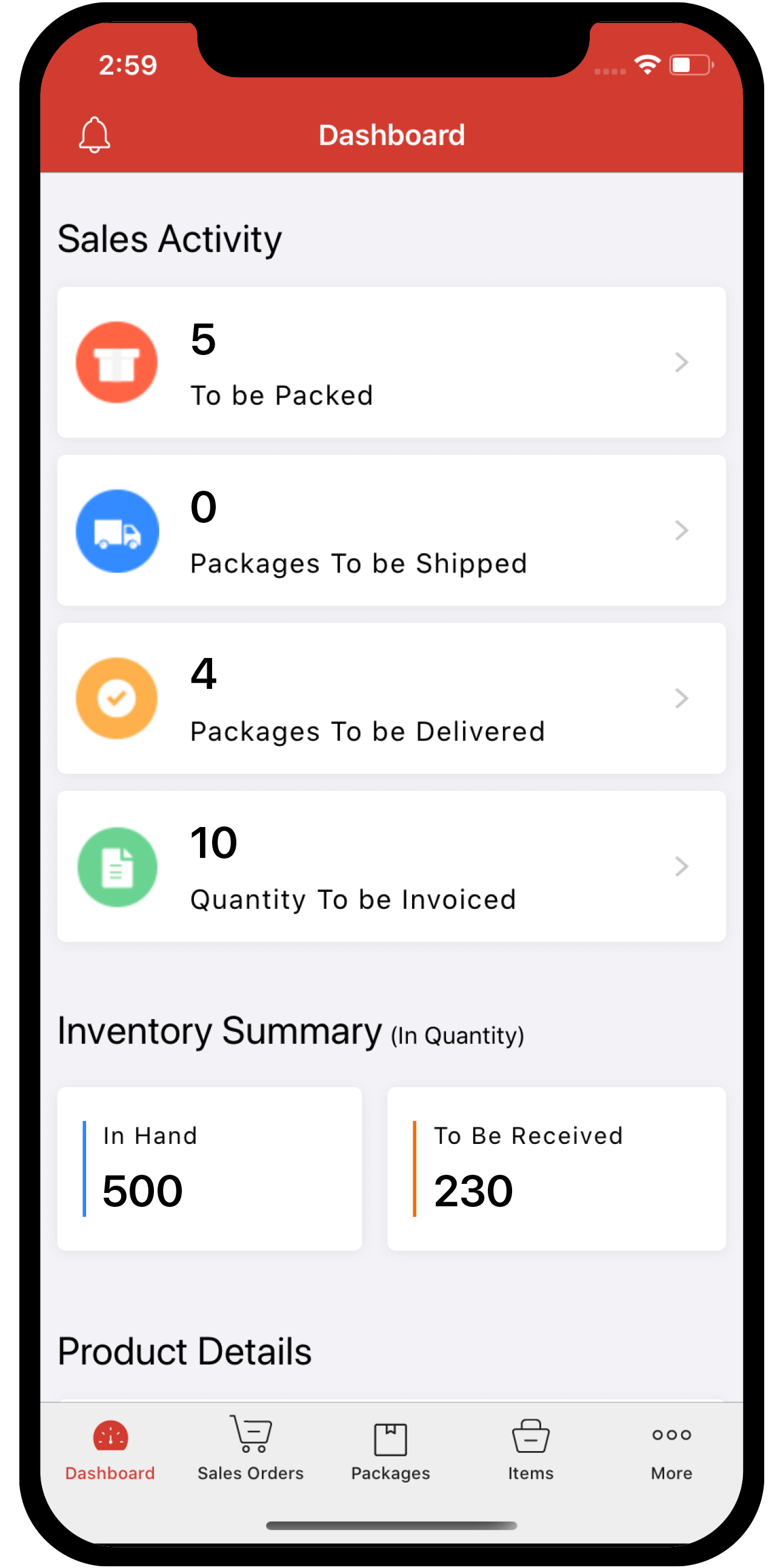 Inventory
Inventory
IN THIS PAGE…
Integrate Zoho Inventory With WhatsApp
Using WhatsApp for customer communication offers an easy way to send messages with a personalized touch. Integrating WhatsApp into Zoho Inventory keeps your customers informed regarding their invoices, sales orders, payment receipts, customer statements, estimates, retainer invoices, credit notes, and sales receipts.
After enabling WhatsApp, you will have to buy credits to send notifications to your customers. Learn more about WhatsApp Credits.
Prerequisites
To integrate Zoho Inventory with WhatsApp, you should have:
- A verified Facebook Business Manager account.
- A WhatsApp Business account.
- A registered mobile number (The mobile number should not have a personal WhatsApp account as WhatsApp Business does not allow it for business purposes.)
Connect to WhatsApp
To send WhatsApp notifications to your customers, you must connect Zoho Inventory to WhatsApp first. Here’s how:
- Go to Settings and then Integrations & Marketplace.
- Navigate to WhatsApp and click Connect near WhatsApp Business.

Incase you have an existing WhatsApp Business account, the Set up WhatsApp Business pop-up will appear.
- Click Use the existing WhatsApp Business account registered with Zoho and select the account from the dropdown to continue using the existing WhatsApp account that is integrated with other Zoho apps. (or)
- Click Connect a new WhatsApp Business account with Zoho to create a new WhatsApp Business account.
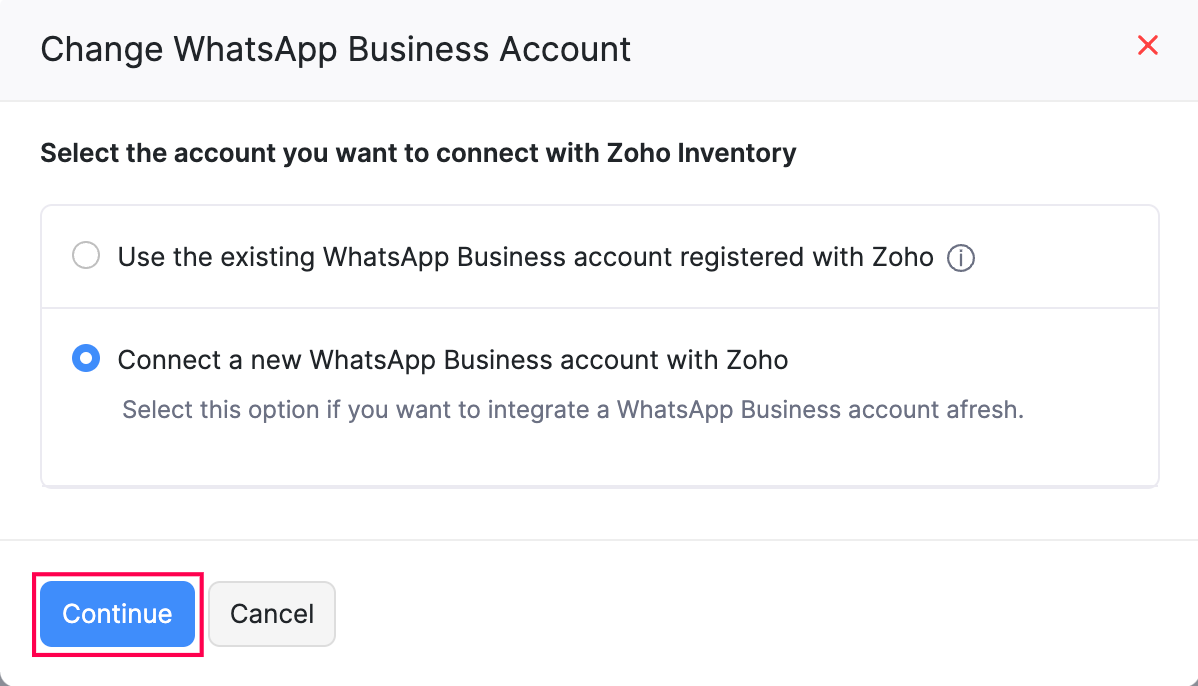
- Read and agree to the terms in the Connect WhatsApp with Zoho Inventory pop-up.
- Click Connect WhatsApp and you will be redirected to the Facebook Login page.
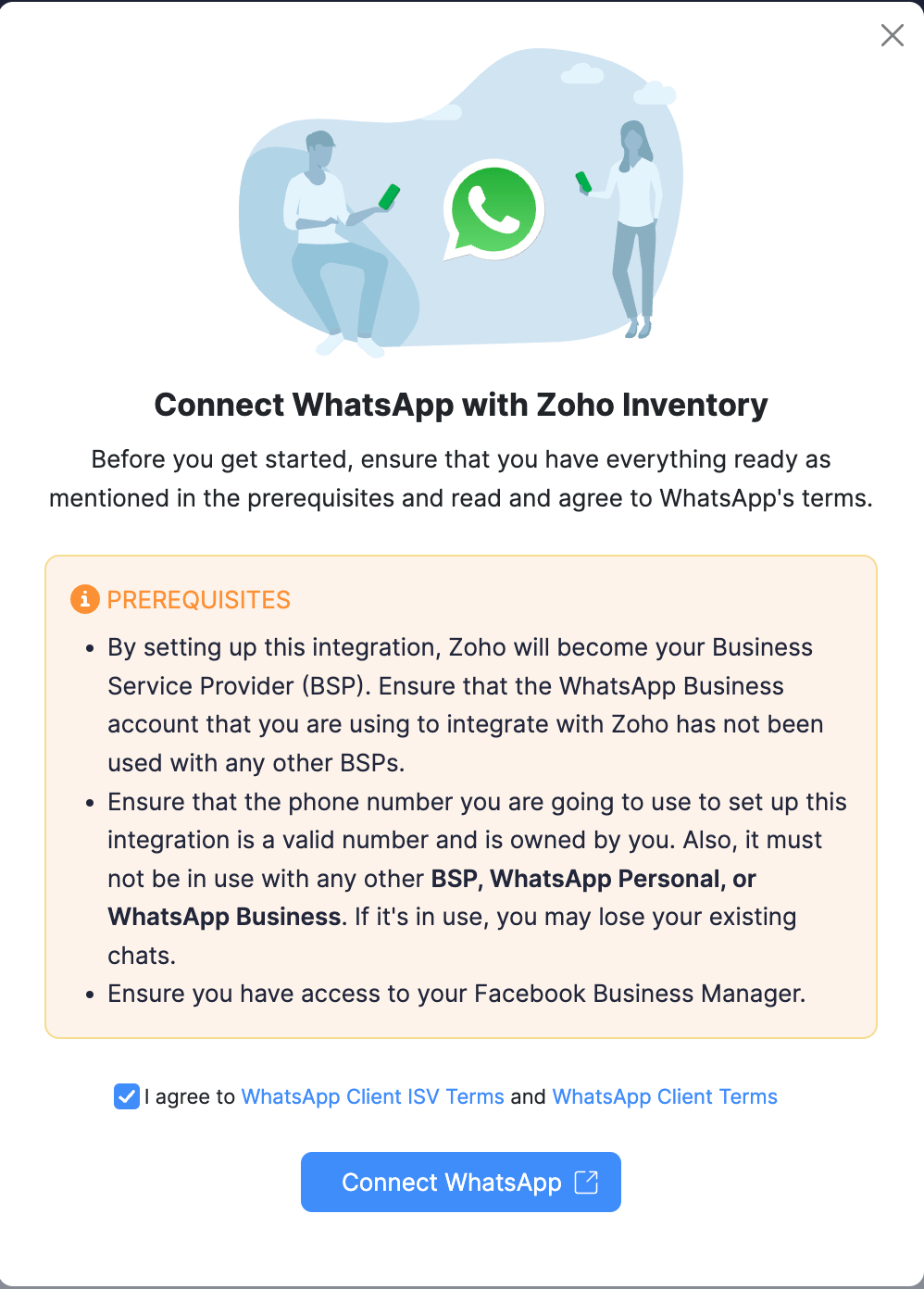
- Enter the registered Email Address or Phone Number and Password and click Log in.
Insight: If you don’t have a Facebook account, create one by clicking Create New Account.

- Verify your account and click Continue as ‘Your Account Name’ in the next page. If you want to log in with another account, click Login to another account.
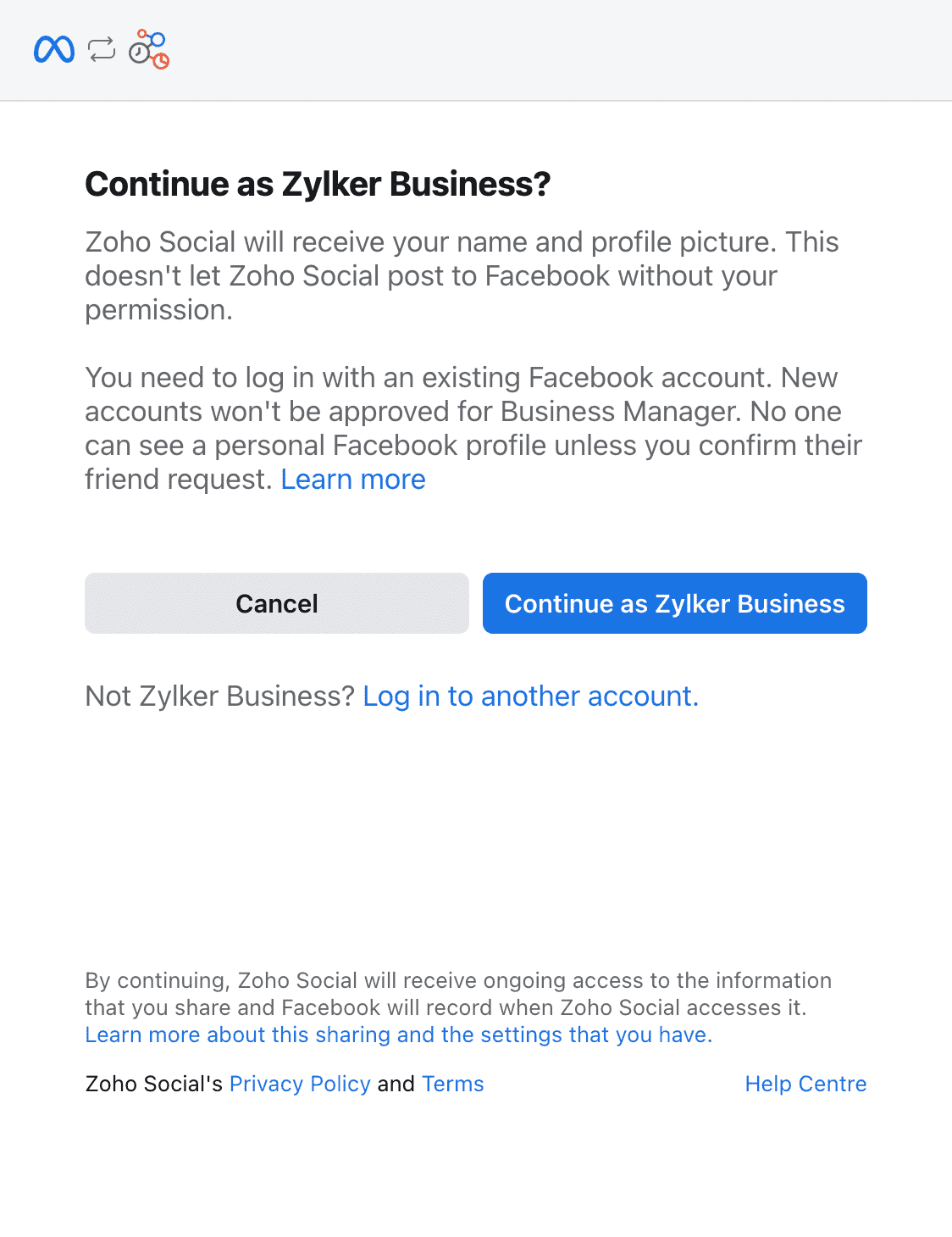
- Read through all the WhatsApp Business Terms of Service and the Meta Terms of Service and click Get Started.

- Fill in your Business Details and click Next.
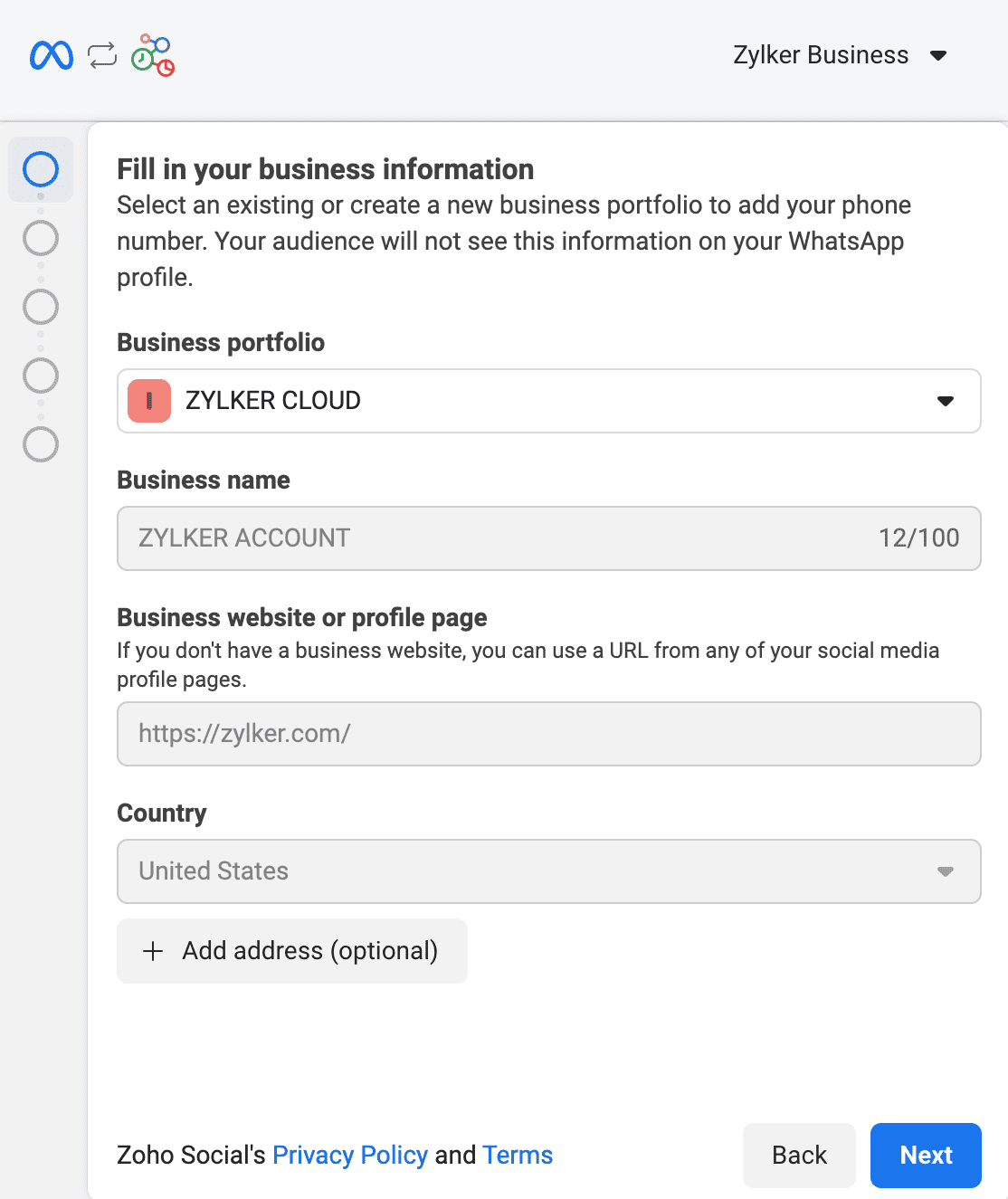
- Select a WhatsApp Business account and WhatsApp Business Profile in the following page.
Insight: If you don’t have one, select Create a WhatsApp Business account and Create a new WhatsApp Business Profile from the dropdown.
- Click Next and click Finish in the page that follows.


Your Zoho Inventory organisation will be connected with WhatsApp.
- Click Continue to select the WhatsApp default number and buy credits.

- Check the WhatsApp channel number from which the WhatsApp messages will be sent to your customers and click Continue. You can either buy credits in the next step or also do it once you have created templates for WhatsApp notifications.
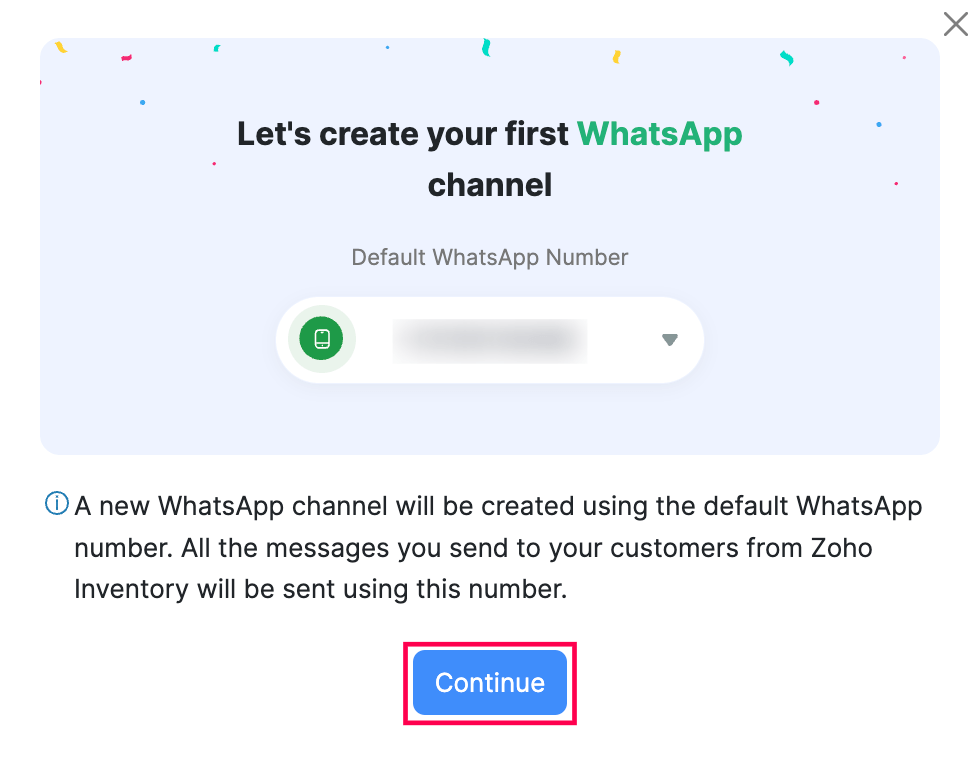
Your Zoho Inventory organization will be connected with WhatsApp.
Configure Templates
To send notifications through WhatsApp, create a template in Zoho Inventory and get it approved by the WhatsApp Business team.
Create Templates
To send invoice details through WhatsApp, you’ll have to create a template for it. Here’s how:
- Go to Settings, navigate to Integrations & Marketplace, and click WhatsApp.
- Select Invoices under Message Templates.
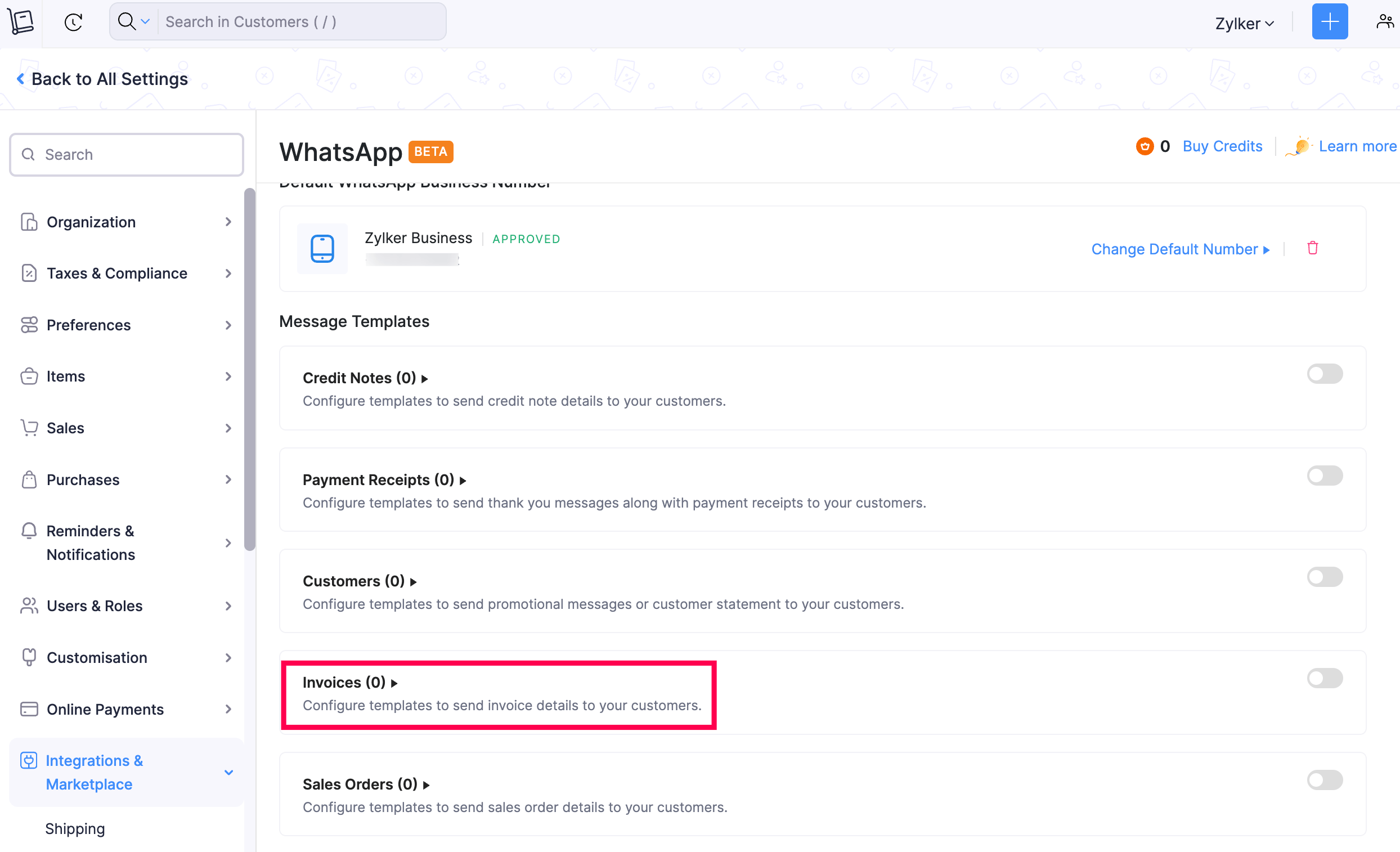
- Click New Template. The Create WhatsApp Template pop-up will appear.

- Fill in the Template Name and Template Category.
Insight: The Template Category could either be Utility or Marketing. Learn more about Template Categorization.
- Mark the Include a PDF attachment along with this message checkbox if you want to include the invoice PDF in the WhatsApp message.
- Click the dropdown next to Language to choose the preferred language for your customers.
- Edit the content under the Message field if required. You can insert placeholders by clicking the dropdown next to Insert Placeholders.
- Click Save.
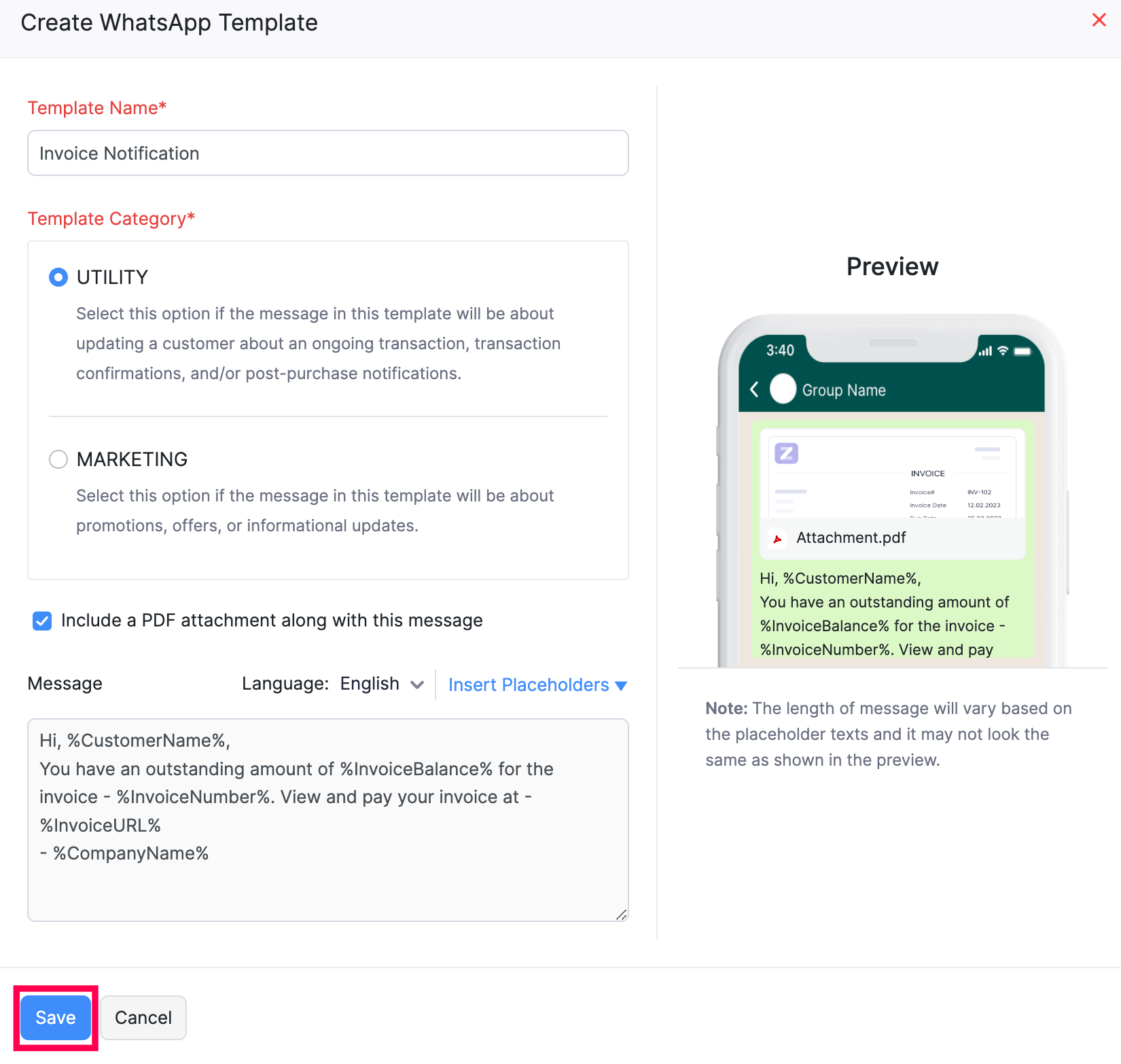
A template will be created, and once approved, you can send invoice notifications to your customers.
Similarly, you can create templates for Sales Orders, Payment Receipts, Customer Statements, Estimates, Retainer Invoices, Credit Notes, and Sales Receipts.
Template Approval
Once you create a template, it will be sent for approval. It can take up to 24 hours for the WhatsApp team to approve it. The status of the approval will be displayed in the list page.

A template can have the following statuses:
| Status | Description |
|---|---|
| Approved | The WhatsApp Business team approved the template and it can be sent to customers. |
| Rejected | The WhatsApp Business team rejected the template. Edit and resumbit the template for approval. Learn why templates get rejected. |
| Pending Approval | The template has been sent to the WhatsApp Business team and is awaiting approval. It could take up to 24 hours for the status to be updated. |
| Deletion in Progress | The WhatsApp Business team is evaluating your request to delete a template. |
| Deletion Failed | The template was not deleted due to network issues. Initiate the delete process once again. |
| Deleted | The WhatsApp Business team has deleted the template. This action cannot be undone. |
Other Actions
Clone Template
If you want to create a template similar to an existing template, you can clone it. Here’s how:
- Go to Settings, navigate to Integrations & Marketplace, and click WhatsApp.
- Select the module under Message Templates.
- Click the More icon next to the template you want to clone and select Clone.
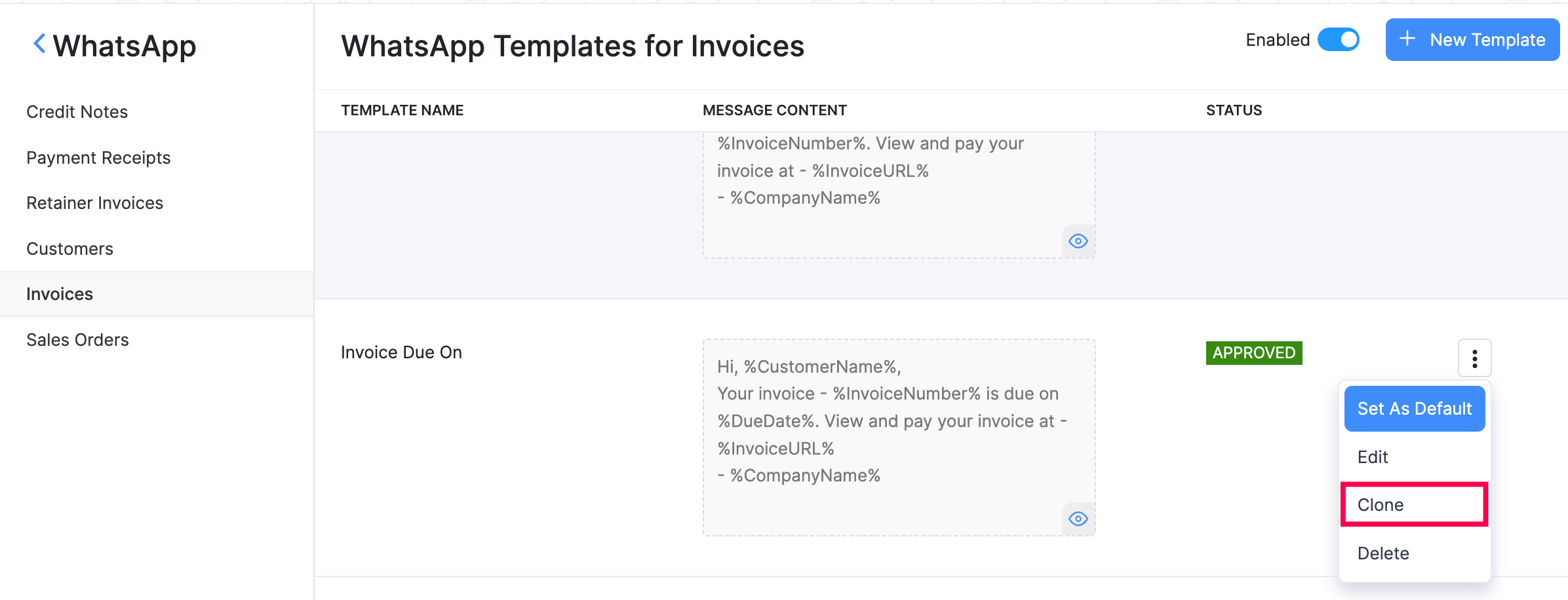
- Edit the details if required, and click Save.
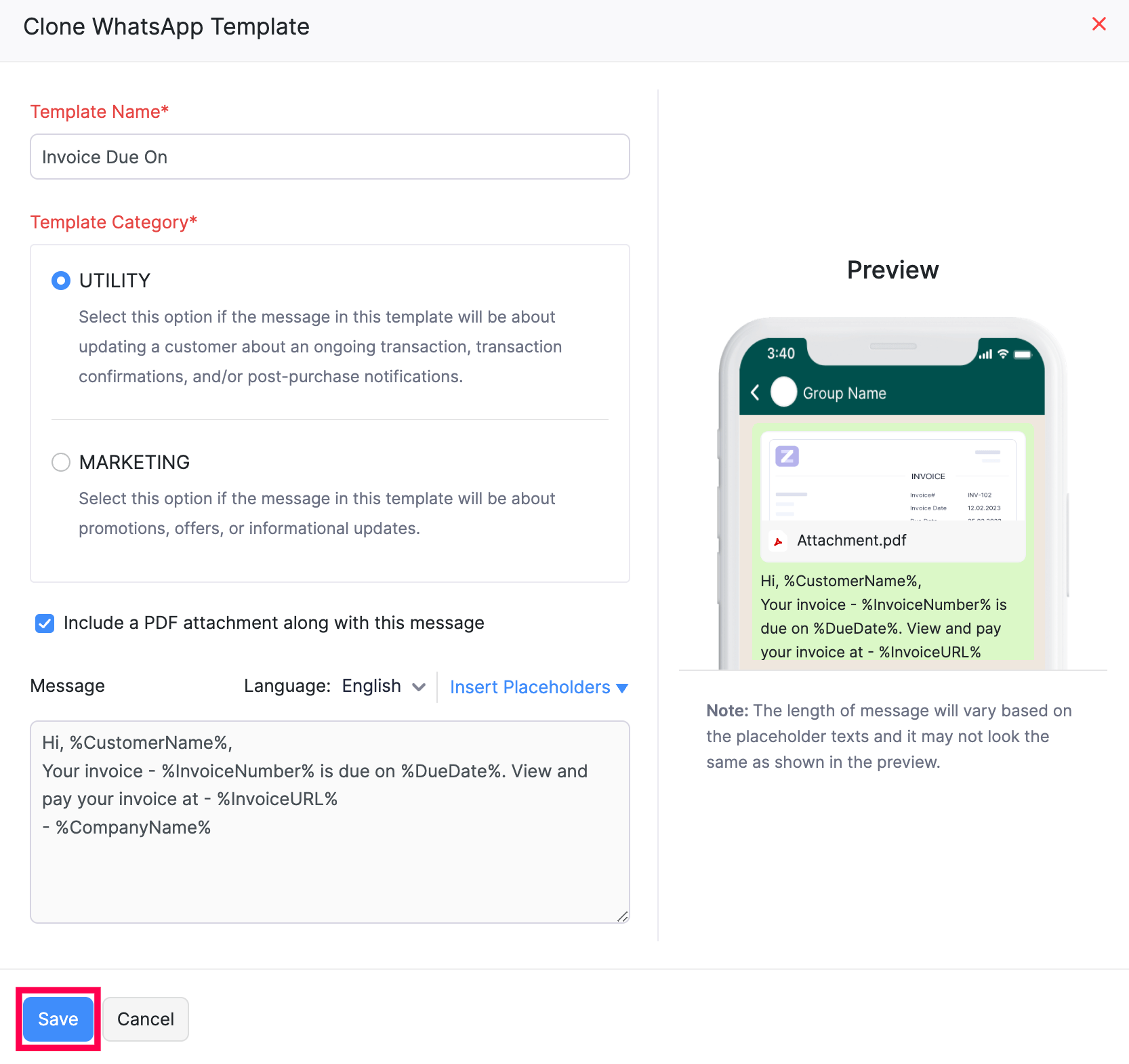
The new cloned template will be sent for approval to the WhatsApp Business team and can be used once approved.
Set Template as Default
If you want a template as your default choice, you can set that template as default. To do so:
- Go to Settings, navigate to Integrations & Marketplace, and click WhatsApp.
- Select the module under Message Templates.
- Click the More icon next to the preferred template and select Set as Default.
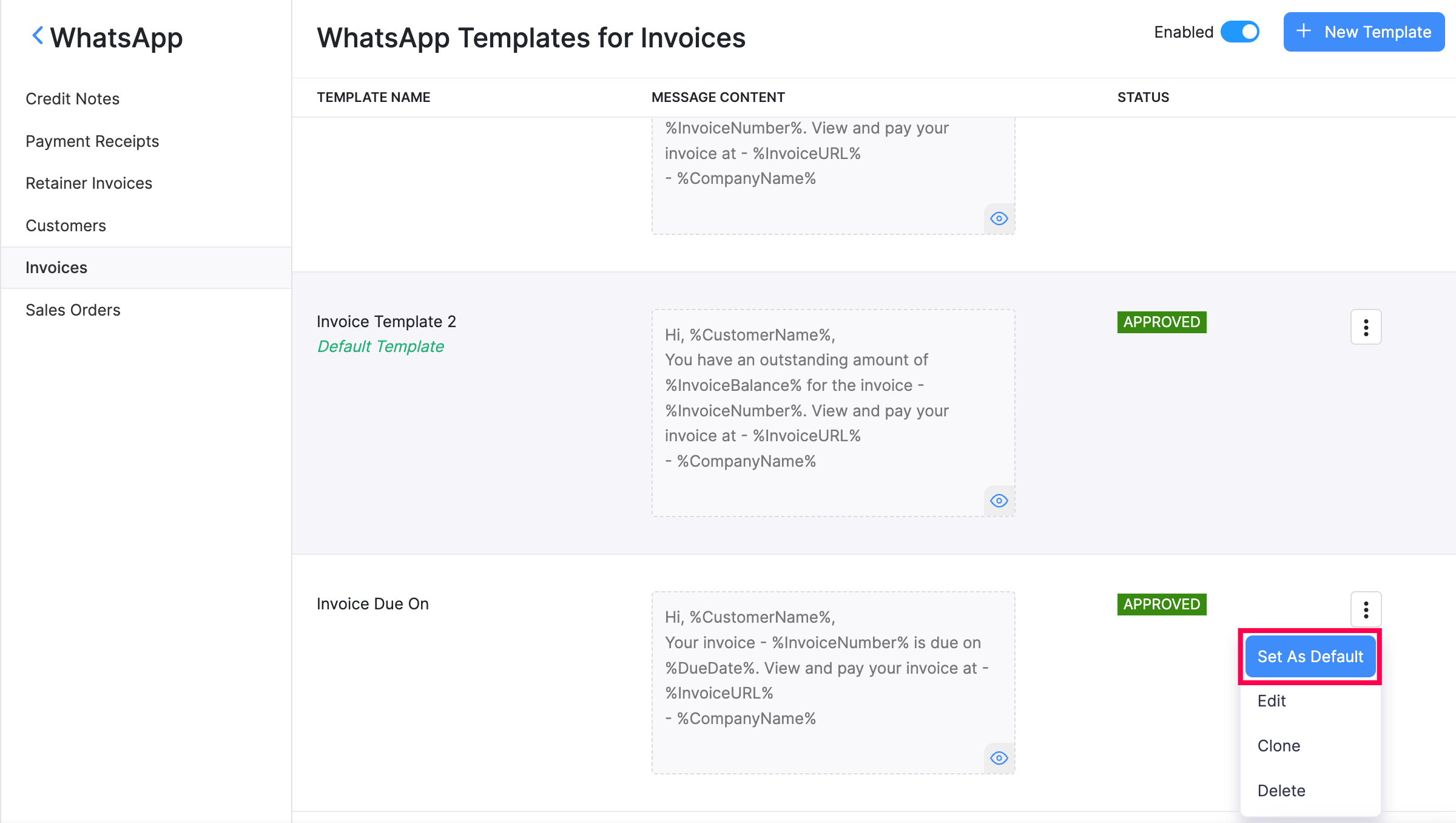
The default template will be auto-populated in the Template Name field when you try to send WhatsApp notifications.
Delete Template
You can delete a WhatsApp template if you do not require it.
Prerequisite: Ensure that the template you wish to delete is not set as the default, as you won’t be able to delete it. You can set another template as default to delete the one that is no longer required.
Warning: Deleting a template is permanent and cannot be undone. However, you can create a new template again and send it to the WhatsApp Business team for approval.
To delete a template:
- Go to Settings, navigate to Integrations & Marketplace, and click WhatsApp.
- Select the module under Message Templates.
- Click the More icon next to the template that you want to delete.
- Click Delete from the dropdown to proceed.
A request will be sent to the WhatsApp Business team to delete the template, which will subsequently, be deleted.
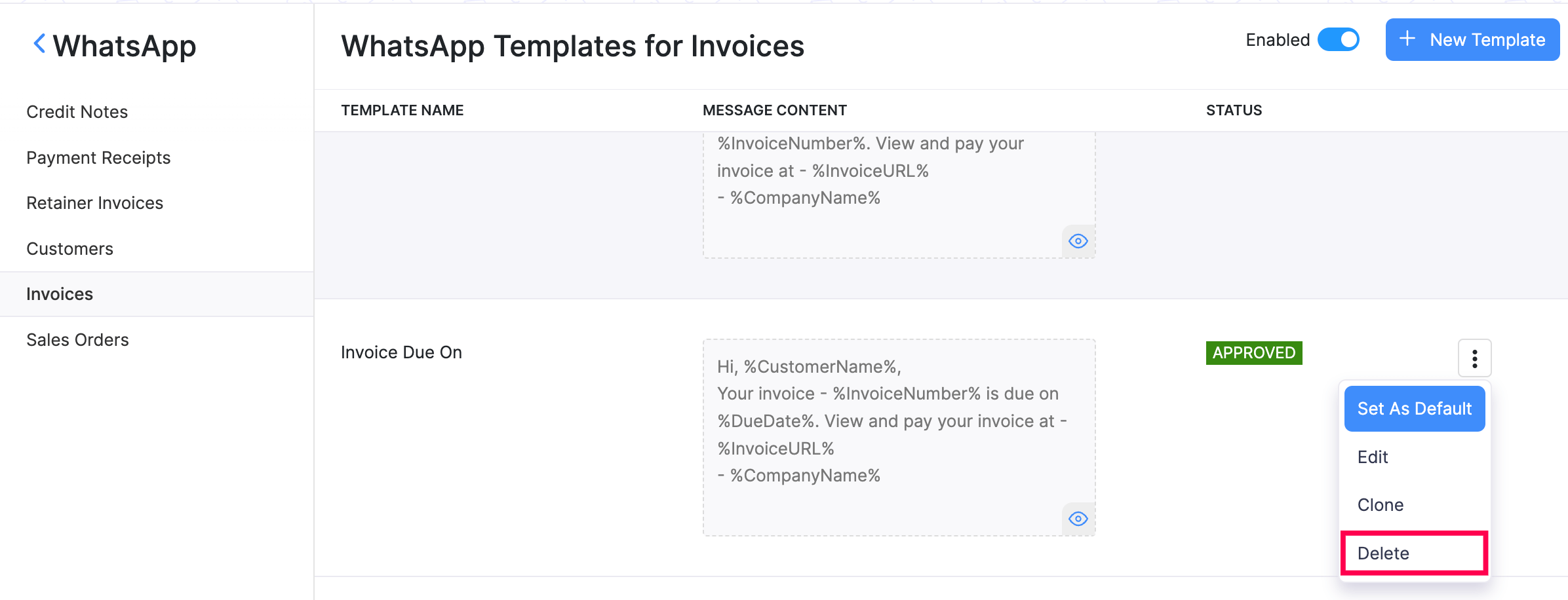
Enable WhatsApp
Enable WhatsApp for Sales Transactions
Once you set up templates, enable the modules for which you’d like to send WhatsApp notifications. To do this:
- Go to Settings, navigate to Integrations & Marketplace, and click WhatsApp.
- Slide the toggle button next to the respective modules.

You’ll be able to send notifications through WhatsApp for the modules which you’ve enabled.
Enable WhatsApp for Customers and Contact Persons
To send notifications to your customers through WhatsApp, you’ll have to enable WhatsApp for them. Here’s how:
- Go to Sales on the left sidebar and select Customers.
- Select the customer for whom you want to enable WhatsApp messaging.
To enable it for the primary contact:
- Click Edit in the Overview section.
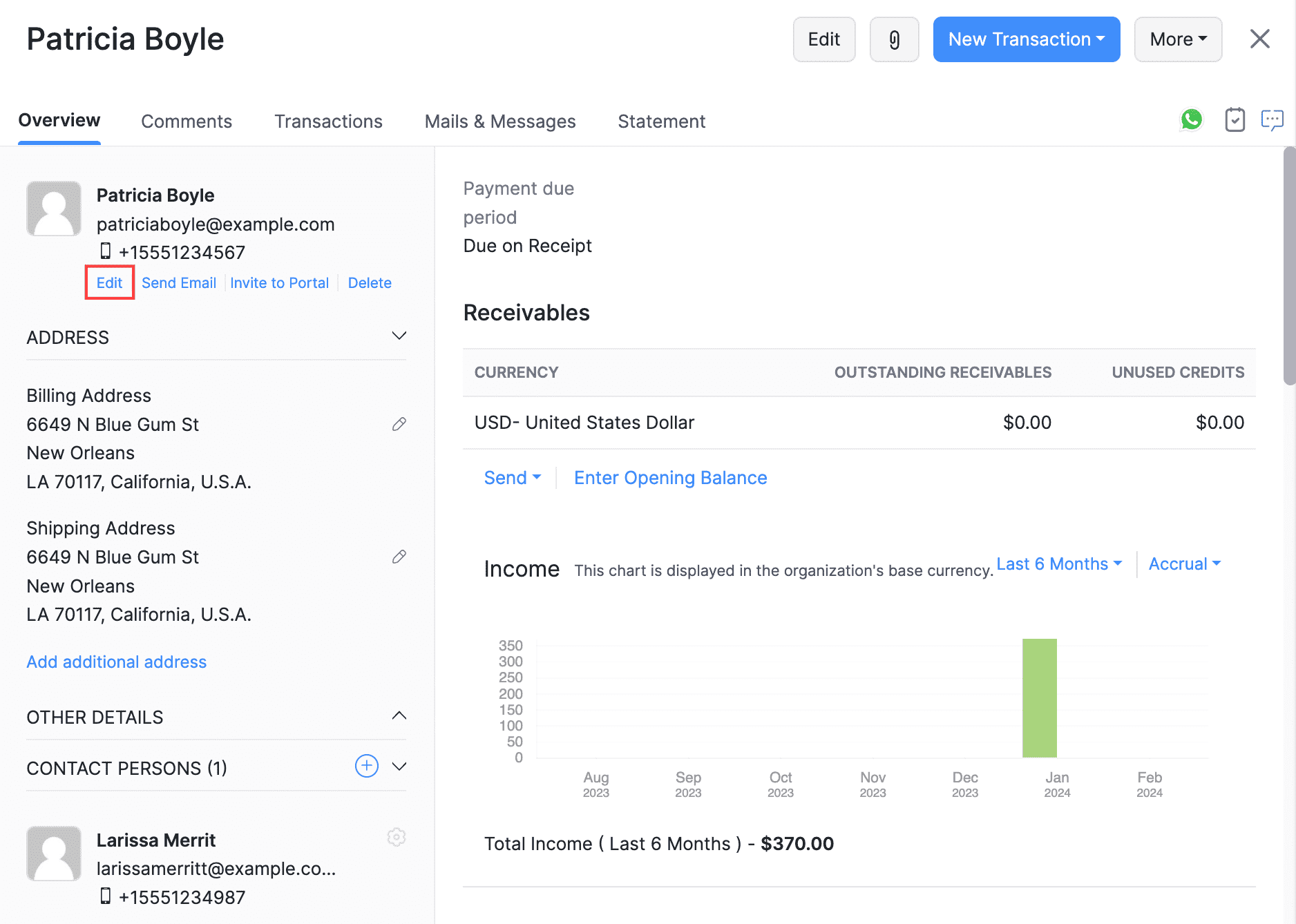
(or)
To enable it for the contact person:
- Scroll down and click the Gear icon next to the contact person and select Edit.
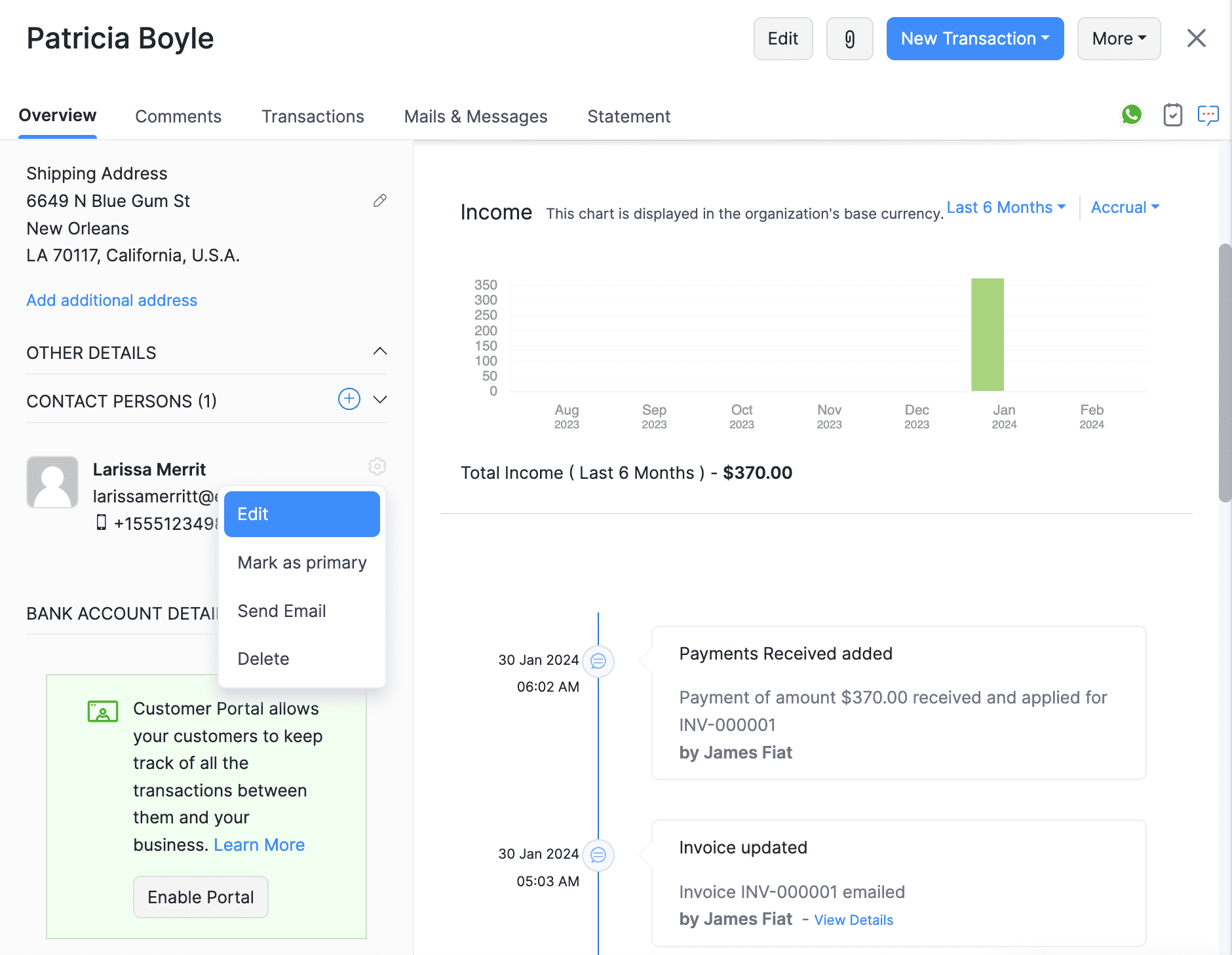
- Ensure that the customer’s phone number is right and begins with a proper country code.
- Mark the option WhatsApp under Communication Channels.
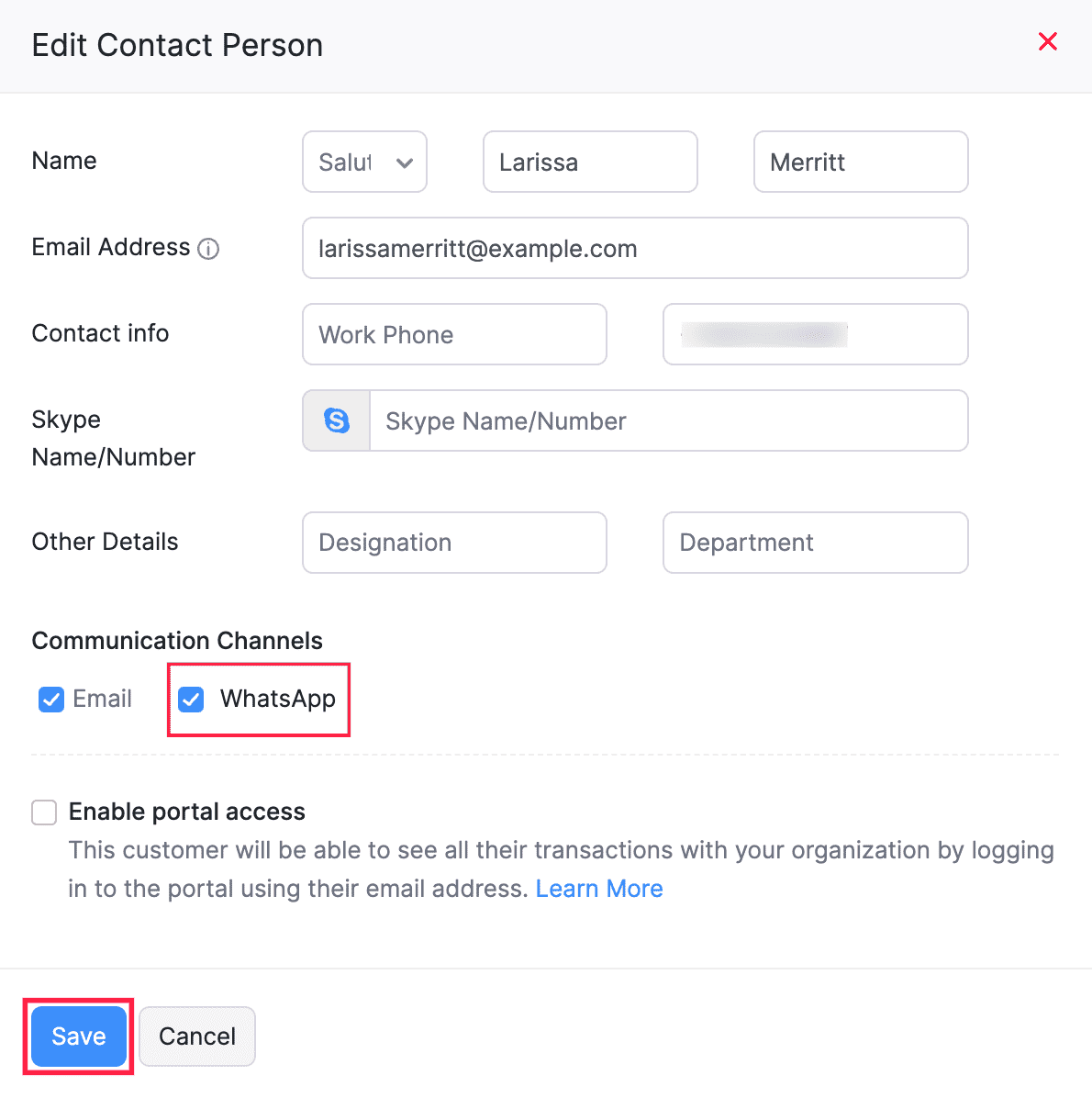
- Click Save and WhatsApp will be enabled for the customer or contact person.
Enable WhatsApp for Customers in Bulk
You can enable WhatsApp messaging for contacts in bulk in two ways. You can enable it for:
- All primary contacts and contact persons
- Specific primary contacts and contact persons
To enable it for all the primary contacts and contact persons:
- Go to Settings, navigate to Integrations & Marketplace, and click WhatsApp.
- Click Update Communication Preference on the right, next to the gear icon.
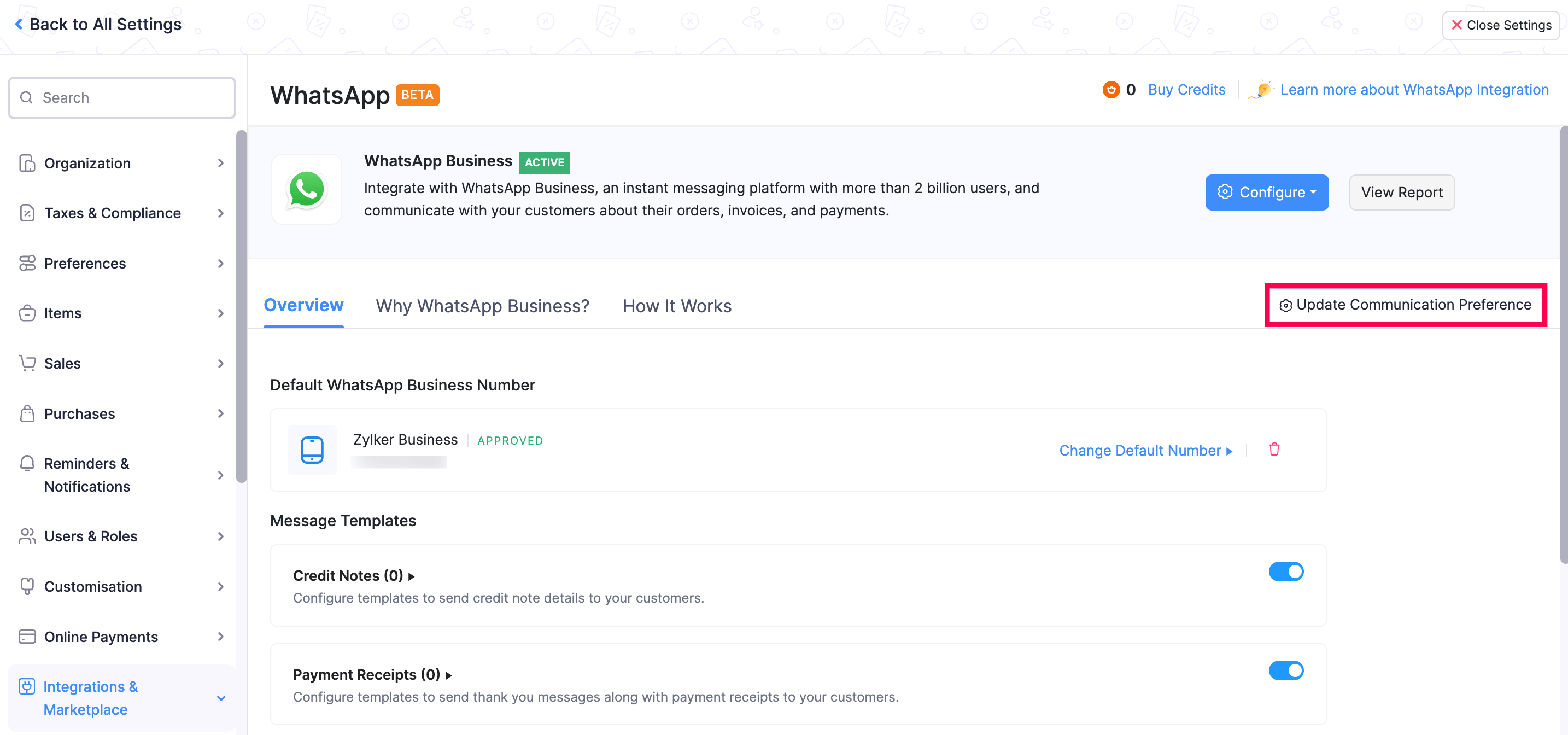
-
In the pop-up that follows, click:
-
Only Primary Contact if you want to send WhatsApp notifications only to the primary contacts.
-
All Contact Persons if you want to send WhatsApp notifications messages to all contact persons, including the primary contacts.
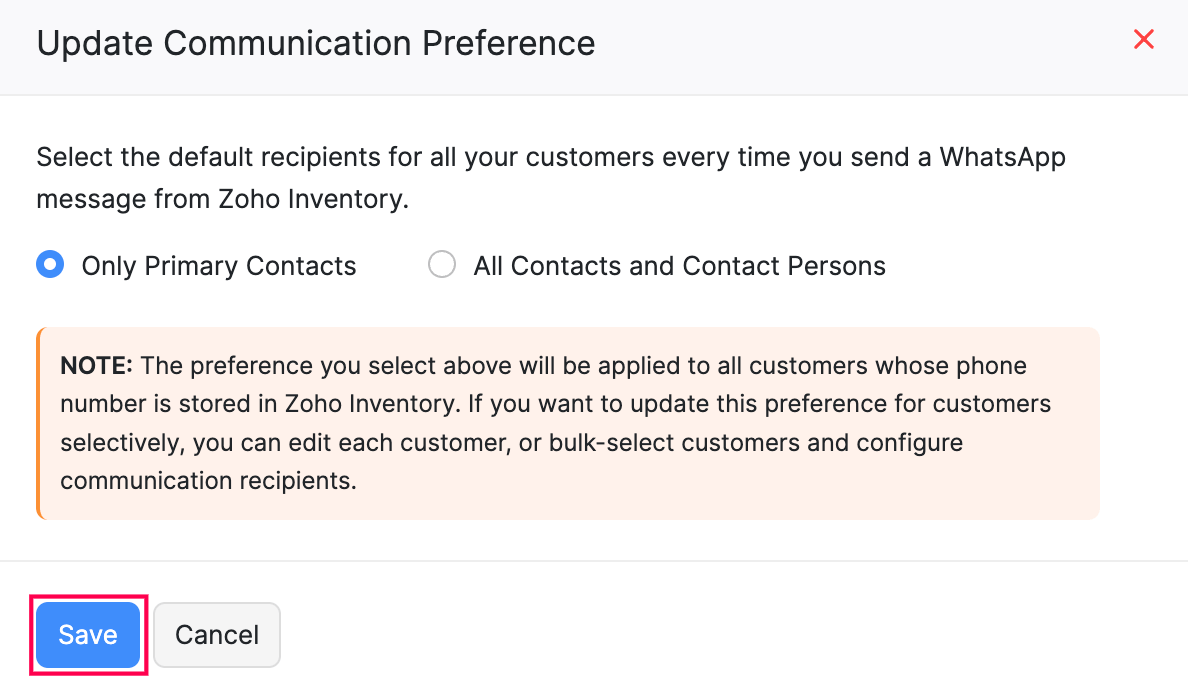
- Click Save.
To enable it for specific primary contacts and contact persons:
- Navigate to Customers under Sales.
- Select the customers you want to message via WhatsApp and click Configure Communication Recipients at the top.

- Configure the default recipients for the WhatsApp channel type in the pop-up that follows.

- Click Save.
The WhatsApp notification will now be sent to the selected contacts.
Manage WhatsApp Credits
How Credits Work
Once you enable WhatsApp and create templates, you’ll need to buy Instant Messaging(IM) credits to send notifications through WhatsApp.
For instance, one credit costs Rs.123.60, and sending a utility message costs Rs 0.250. Therefore, on an average, you can send 400 or more WhatsApp utility messages for just one credit.
Each time a WhatsApp notification is sent, the amount will be reduced according to the template category and the recipient’s region. View WhatsApp’s conversation charges and rate card.
Buy IM Credits
To buy IM credits:
- Go to Settings, navigate to Integrations & Marketplace, and click WhatsApp.
- Click Buy IM Credits at the top-right corner.
- Enter the number of credits required in the Credits field.
- Click Calculate Price and then click Make Payment.
You’ll be redirected to the payment gateway where you can pay. Once done, the credits will be added to your organization. You can also buy IM credits from Zoho Store.
IM Credits Usage Report
In Zoho Inventory, you can view and keep track of your IM (Instant Messaging) credits usage directly from the Reports module. This helps you monitor and manage your IM credits efficiently.
To view the IM Credits Usage report:
- Go to Reports on the left sidebar.
- Select IM Credits Usage under Activity.
You can view the details of the IM credits you had used for your WhatsApp Business account.
WhatsApp Notifications Report
In Zoho Inventory, you can view and monitor the messages you send your customers from your WhatsApp Business account. This allows you to keep track of the type of notifications sent to your customer and its status.
To view the WhatsApp Notifications report:
- Go to Reports on the left sidebar.
- Select WhatsApp Notifications under Activity.
You can view the details of the notifications sent to your customers. You can also customise this report. Here’s how:
- In the WhatsApp Notifications page, select the Date Range for which you want to generate the customised report.
- Click + More Filters at the top of the page.
- In the pop-up that appears, apply the required filters and click Run Report.
The custom report will be generated, based on chosen preferences. Subsequently, you can view the original report again. You can also schedule, export, or share the custom report.
Send Notifications through WhatsApp
Send Invoice Notifications
- Go to Sales and select Invoices.
- Click New at the top-right corner and enter the necessary details.
- Select the contact persons to whom you want to share the Invoice details from the Share invoice with dropdown and click Save and Send.
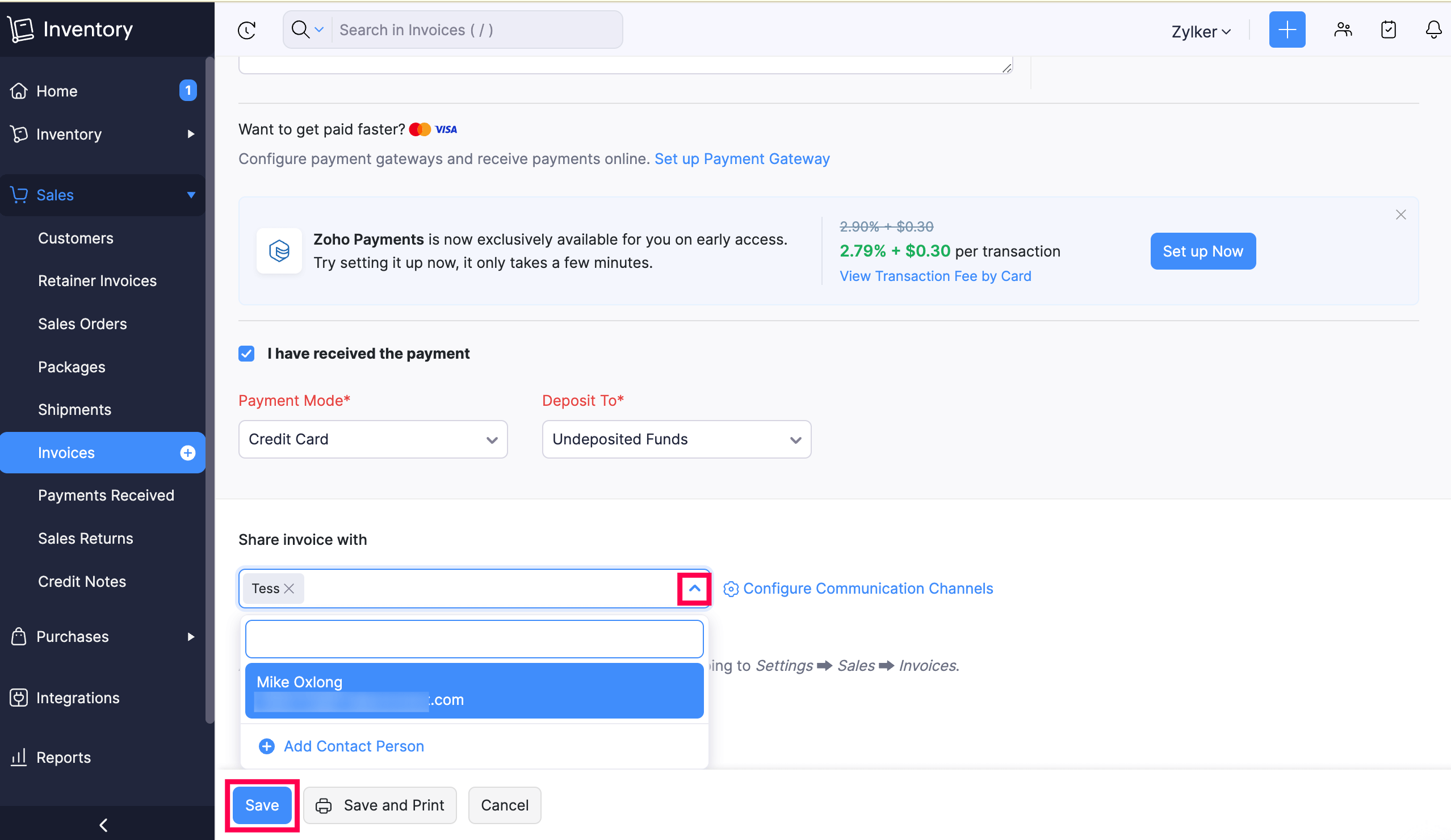
- In the screen that follows, verify the Message Template and Contacts, and click Send.
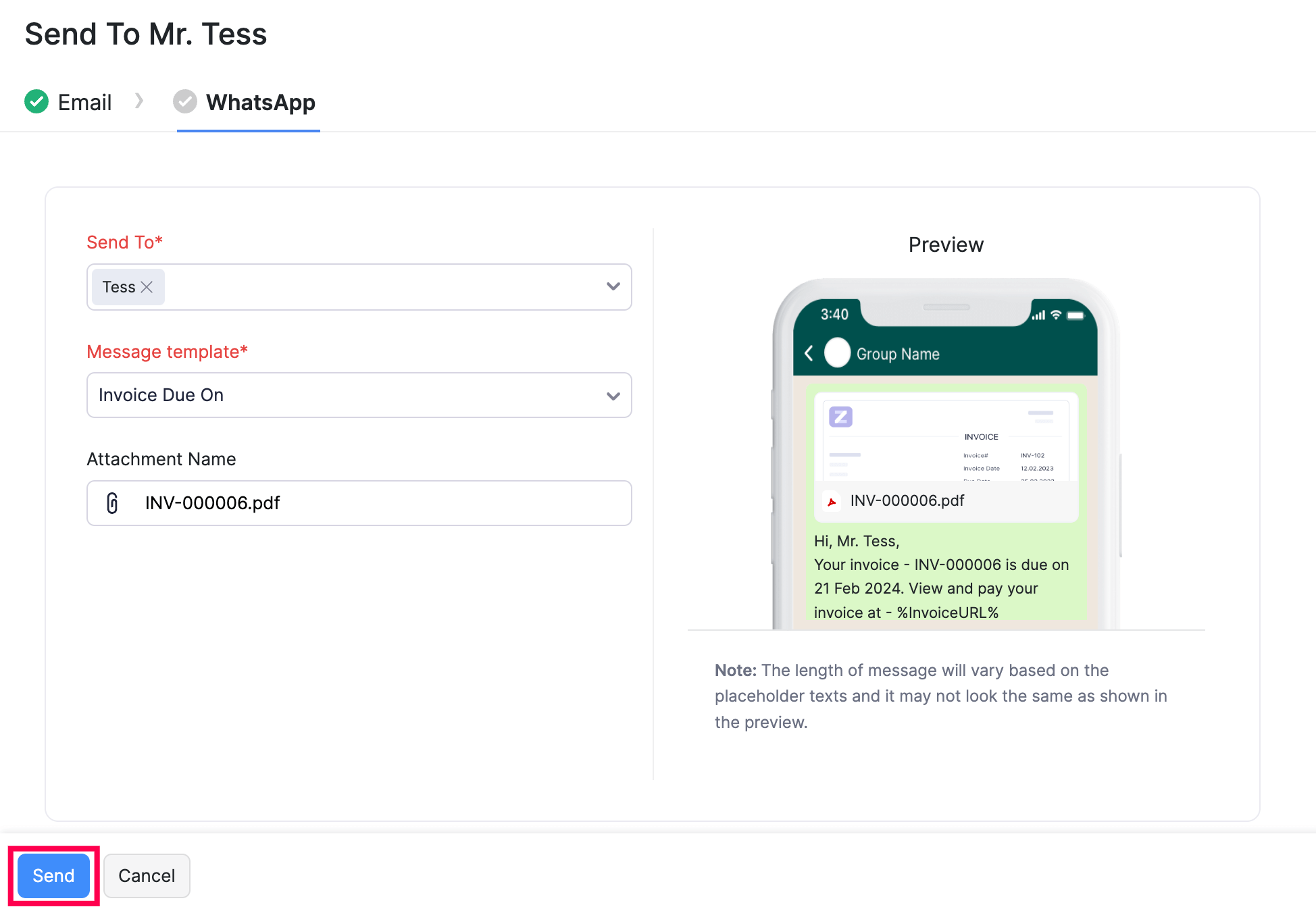
The invoice notification will be sent to the respective contacts.
To send a WhatsApp notification for existing invoices:
- Go to Sales and navigate to Invoices.
- Select the invoice for which you want to share the invoice details.
- Select WhatsApp Message from the Send dropdown.
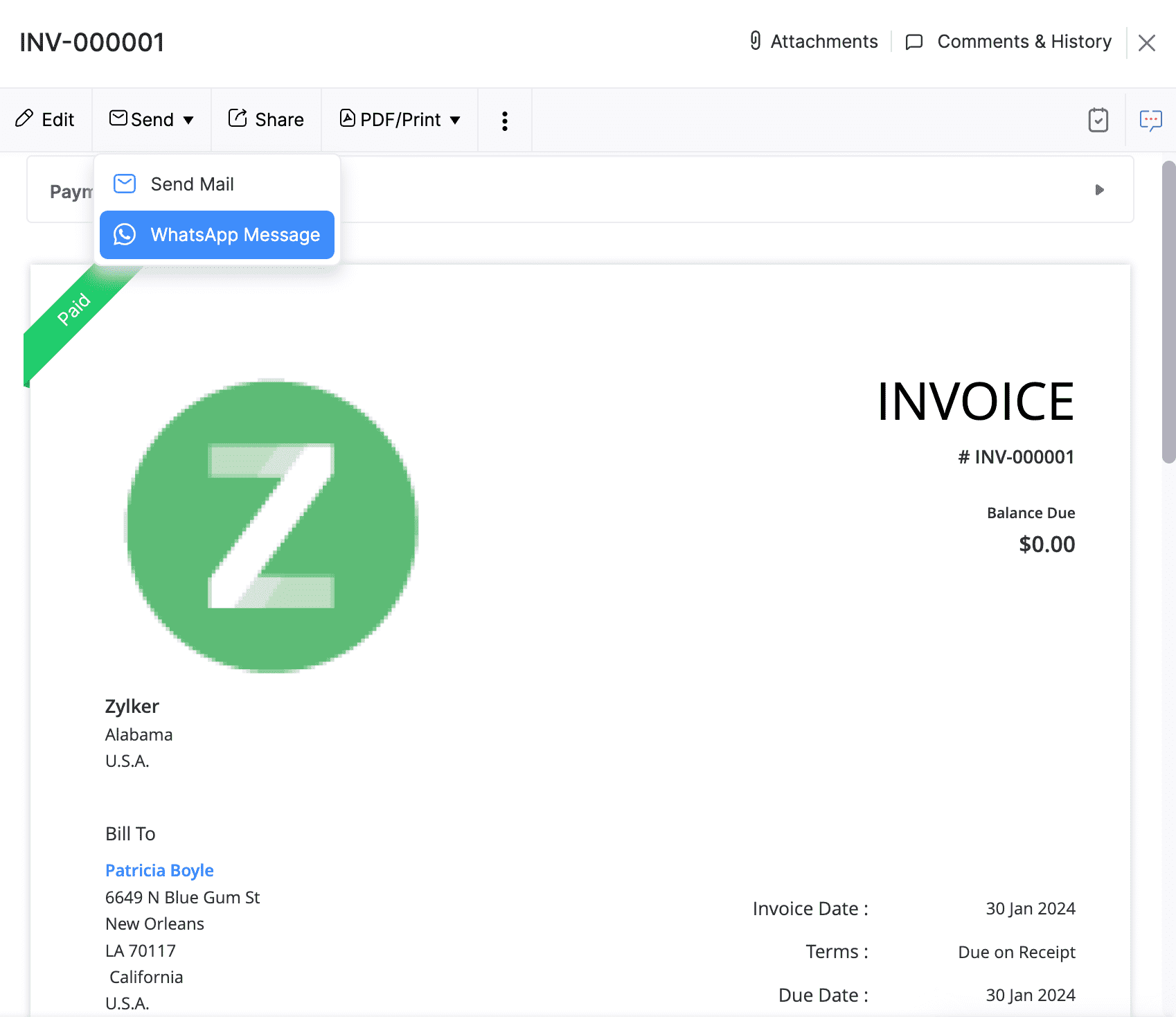
-
The contact person and the message template will be auto-populated in the following Send WhatsApp Message pop-up.
-
Click Send.
The invoice details will be sent to the respective contact person via WhatsApp. Similarly, you can send notifications for Sales Orders, Payment Receipts, Retainer Invoices, and Credit Notes.
Send Payment Receipts
- Go to Sales and select Payments Received.
- Click New at the top-right corner and enter all the necessary details.
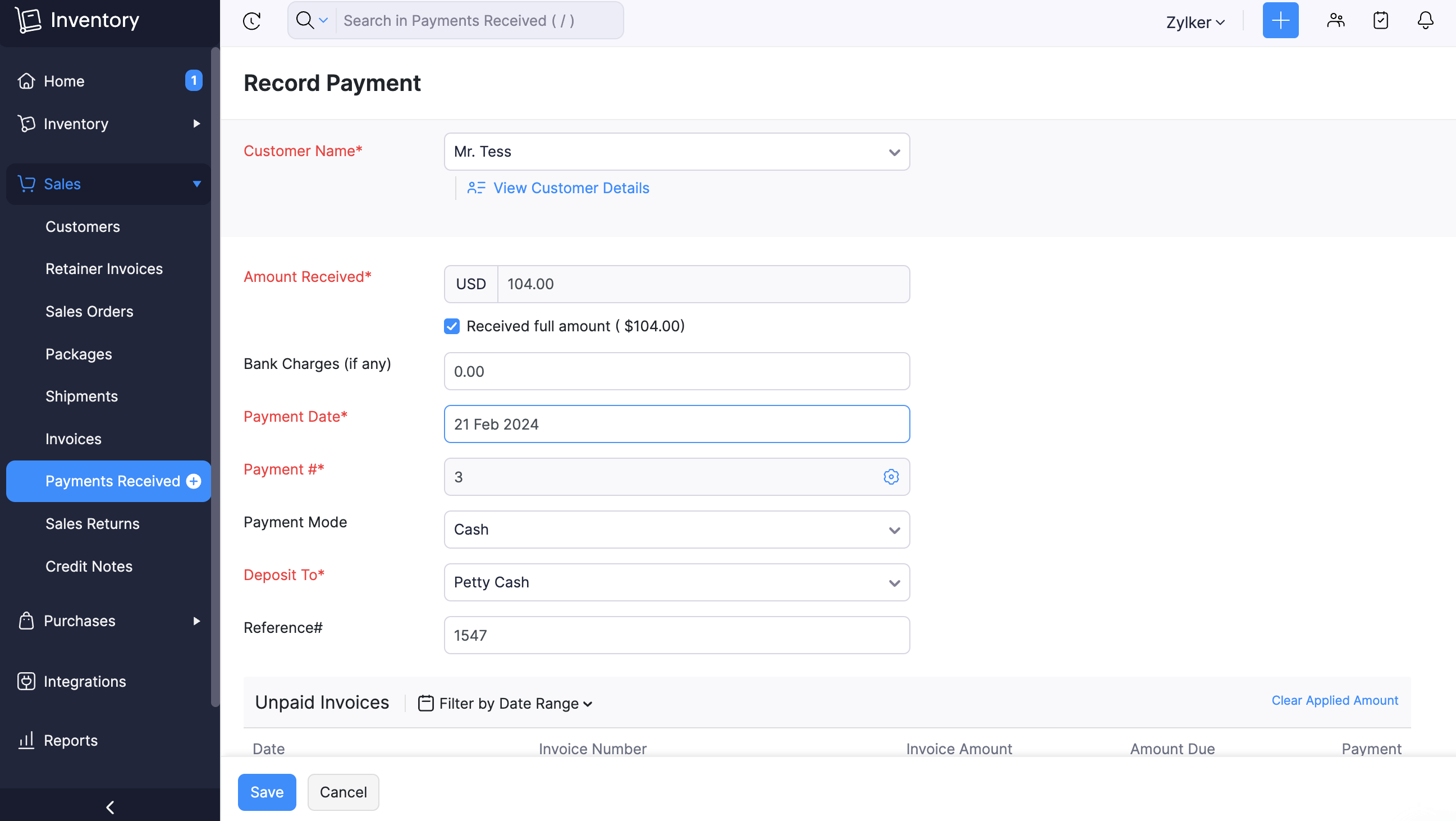
- Select the contact person to whom you want to share the payment receipt details from Share payment receipt with dropdown.
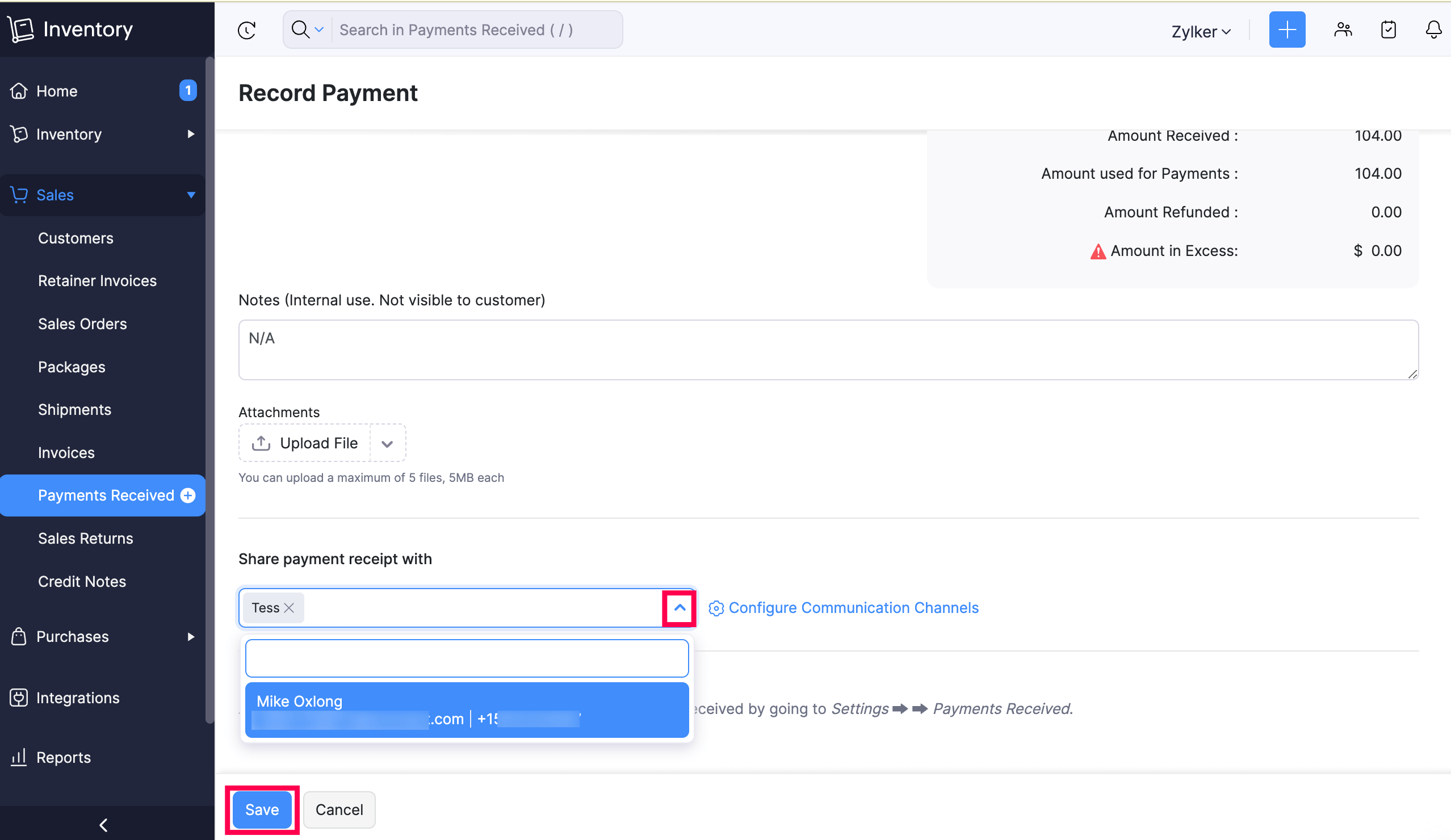
- Click Save and the WhatsApp notification with the payment receipt details of the payment amount and the invoice number will be sent to the respective contact person.
To share existing payment receipts via WhatsApp:
- Go to Sales and navigate to Payments Received.
- Select the payment for which you want to share the payment receipt.
- Click the dropdown next to Send and select WhatsApp Message.
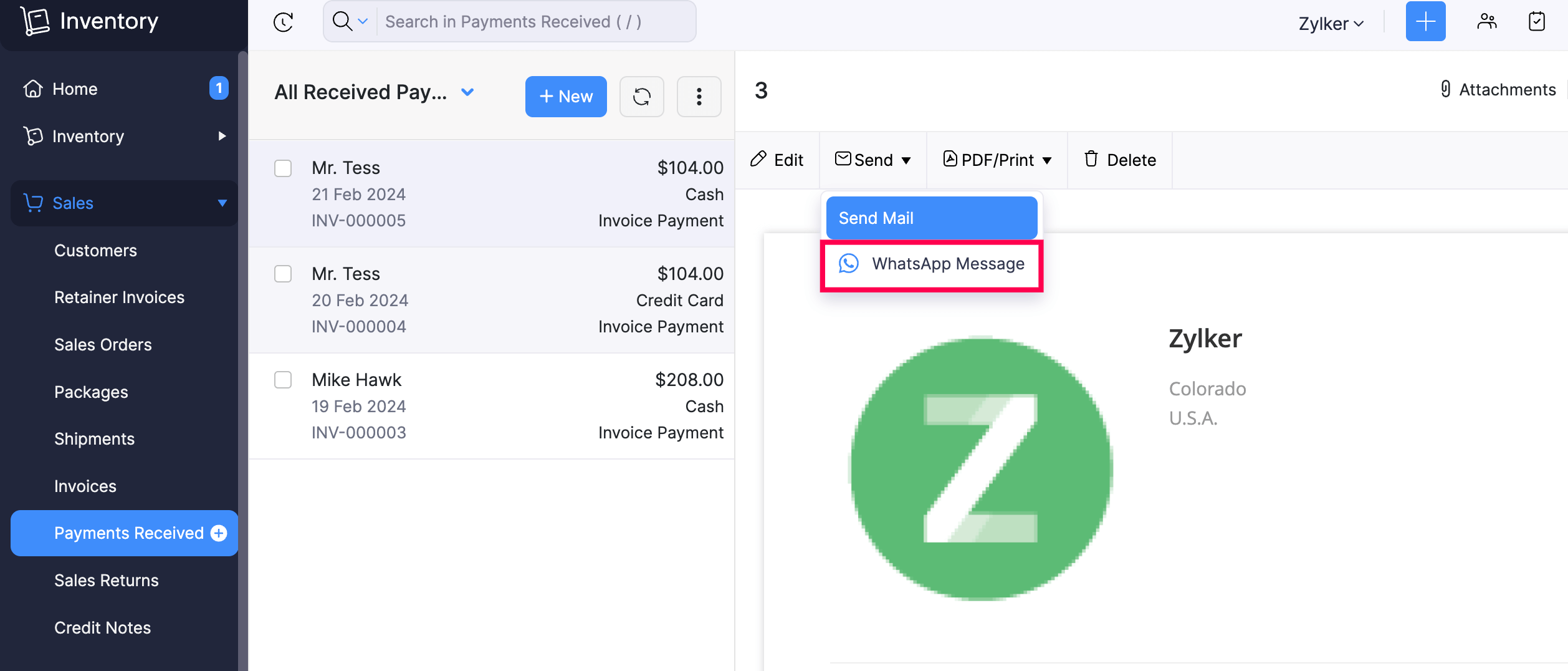
- The contact person and the message template will be auto-populated.
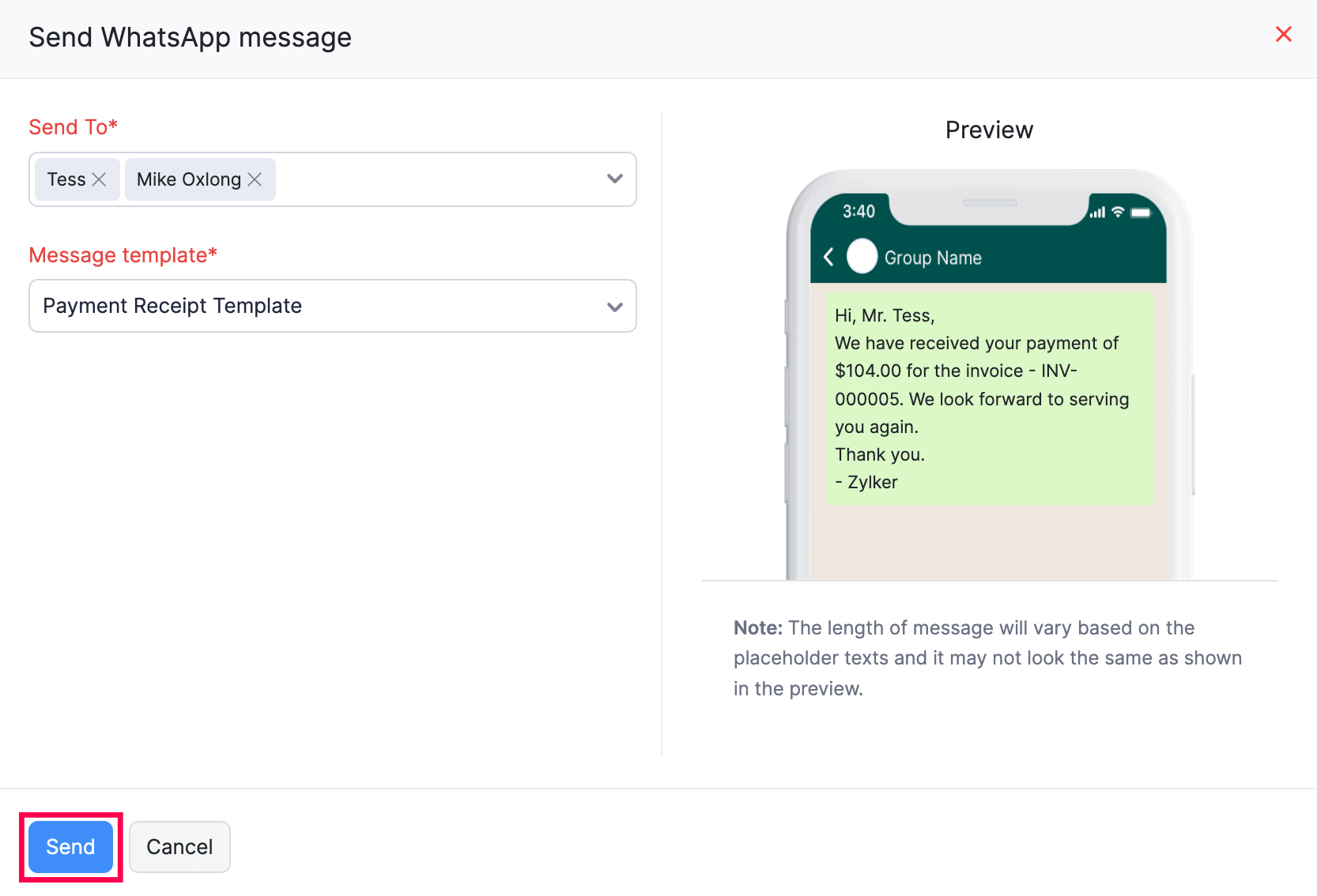
- Click Send and the WhatsApp notification with the payment receipt details will be sent to the respective contact person.
Send Customer Notifications
You can send marketing notifications to your customers regarding promotions, offers or any other informational updates along with the customer statement using this feature.
- Go to Sales and navigate to Customers.
- Select the customer to whom you want to send the WhatsApp notification.
- Go to the Overview and navigate to Receivables section.
- Select WhatsApp Message from the Send dropdown.
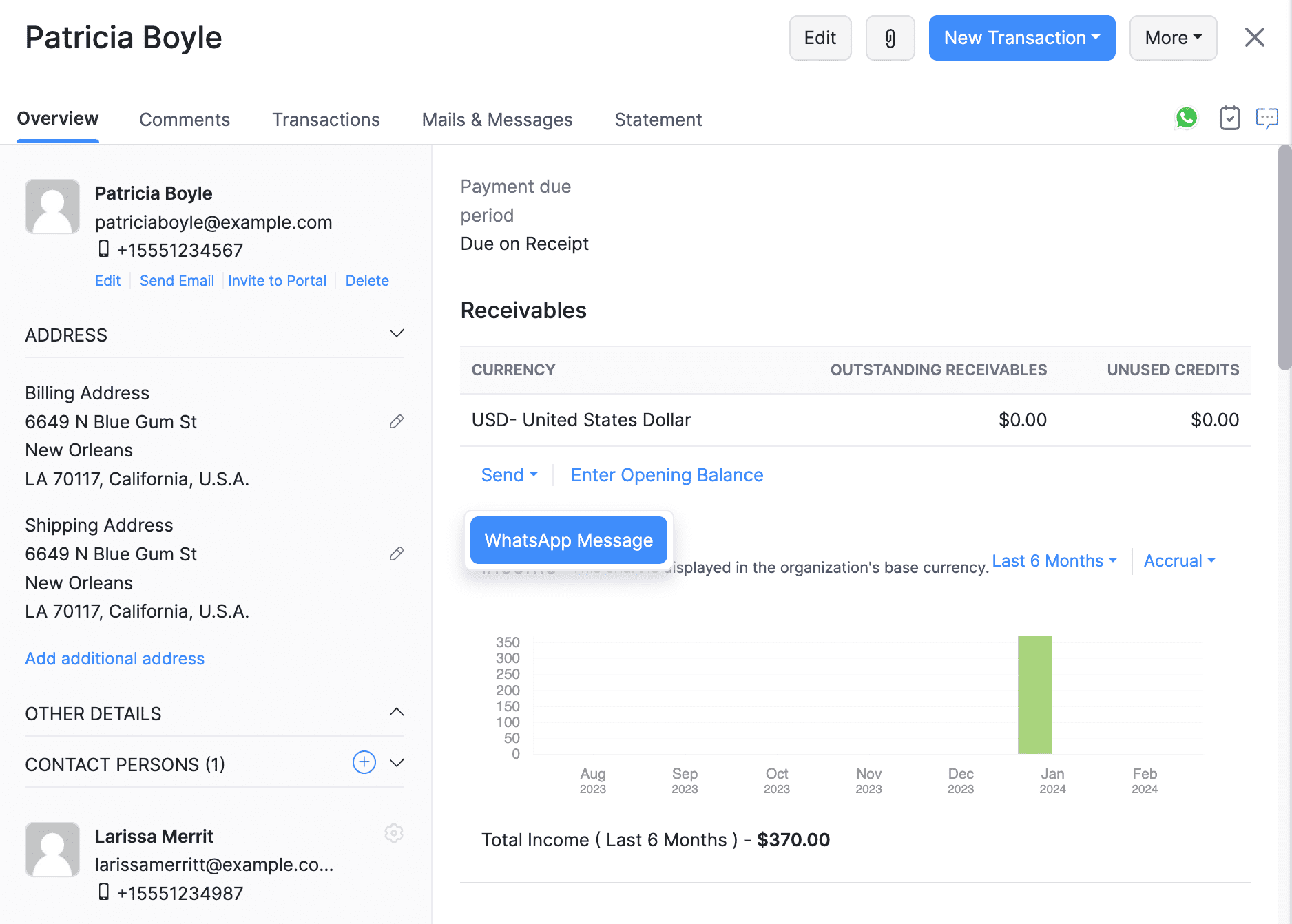
- The contact person and the message template will be auto-populated in the following Send WhatsApp Message pop-up.
- Click Send and the WhatsApp notification will be sent to the respective contact person.
To send only the customer statement:
- Select a customer and switch to the Statement tab.
- Click Share via and select WhatsApp from the dropdown.
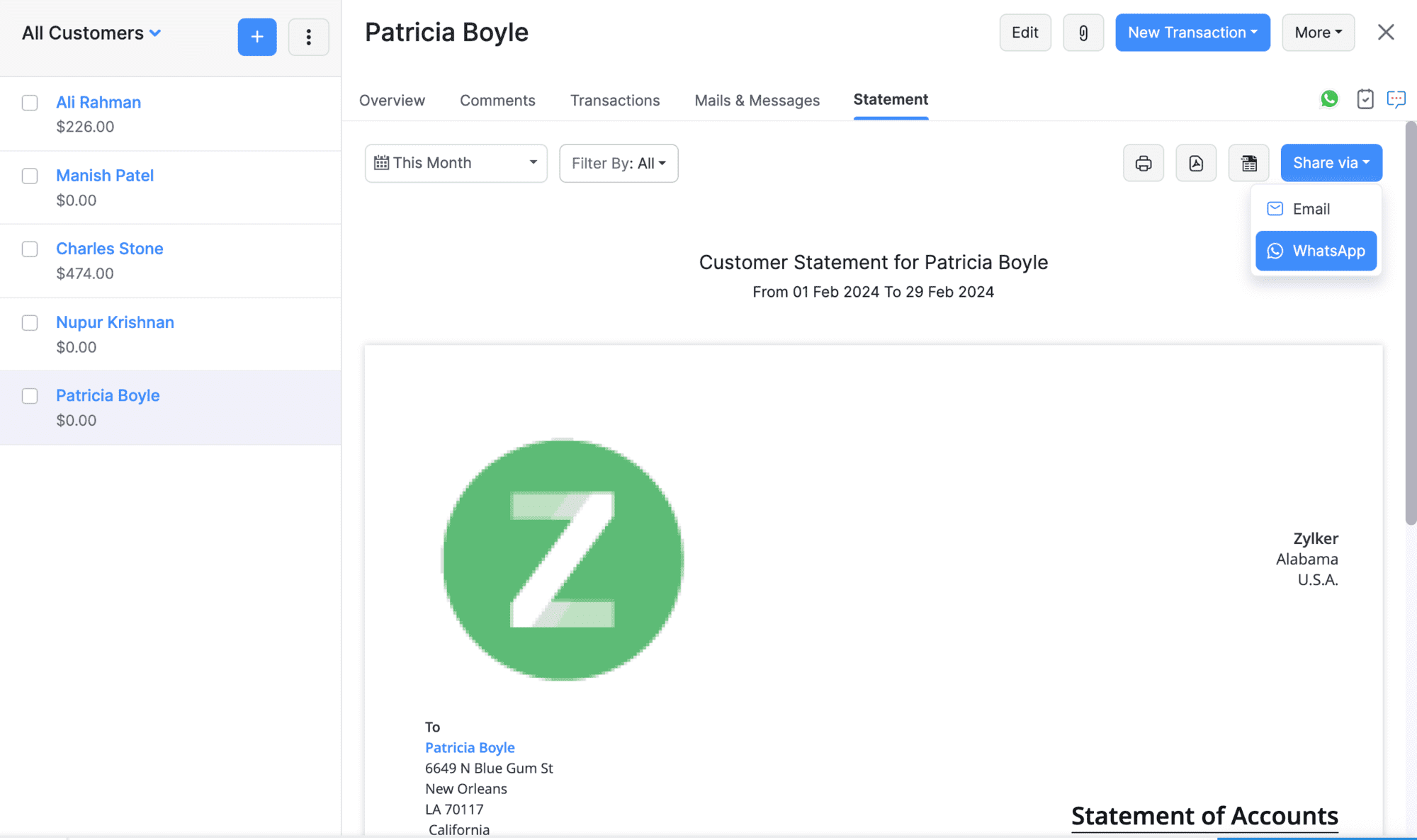
-
The contact person and the message template will be auto-populated in the following Send WhatsApp Message pop-up. You can also add other contact persons or replace the templates if required.
-
Click Send.
The customer statement will be sent to the respective contact person.
View Sent WhatsApp Notifications
You can view the sent WhatsApp notifications at three different levels. Here’s how:
At Transaction Level
- Click the respective transaction in Invoices or other module.
- Go to Comments & History at the top-right corner.
- Click Show Details.

You can view the customer details and the status of the WhatsApp notification.
At Customer Level
- Click the customer whose WhatsApp notifications messages you want to view.
- Navigate to the Mails & Messages tab.
- Click the dropdown next to System Mails and select WhatsApp Messages.

You can view all the WhatsApp notifications and their statuses sent to this customer.

At organization Level
- Navigate to Reports on the left sidebar.
- Scroll down to Activity and click WhatsApp Notifications.

You can also click View Report in the WhatsApp configuration page and view all the WhatsApp notifications sent from your organisation.

Other Actions
Mark WhatsApp as Inactive
If you want to disable the WhatsApp integration temporarily, you can mark it as inactive. Here’s how:
- Go to Settings, navigate to Integrations & Marketplace and click WhatsApp.
- Click Mark as Inactive .
WhatsApp will be disabled for your organization until you mark it as active.

Note: You can enable WhatsApp whenever required by clicking Mark as Active.
Change Default WhatsApp Number
If you want to change the default WhatsApp number:
- Go to Settings, navigate to Integrations & Marketplace, and click WhatsApp.
- Click Change Default Number under the Default WhatsApp Business Number section.

- Select the number you want to set as the default WhatsApp number from the pop-up that follows.
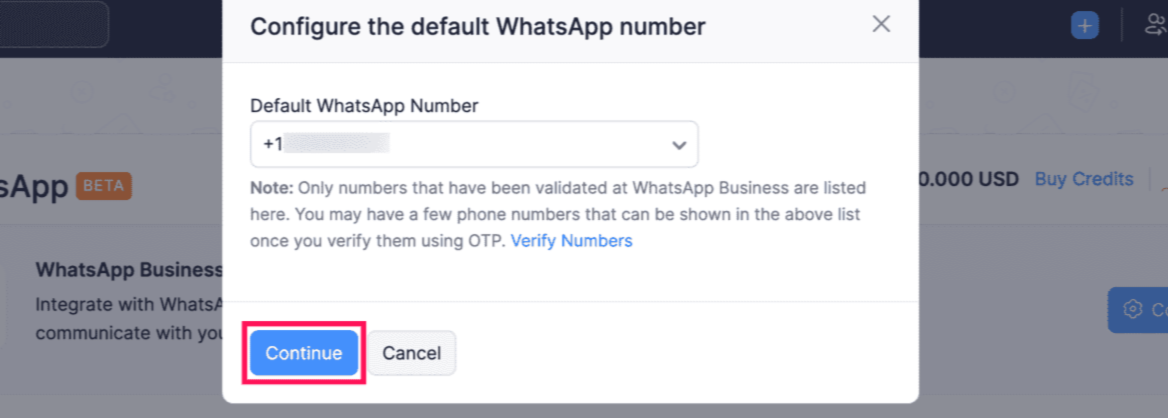
- Click Send OTP to verify the number. You can also choose to get the OTP via call.
Insight: If you haven’t verified the WhatsApp Business number, it will not be listed in the dropdown. In that case, click Verify Numbers.
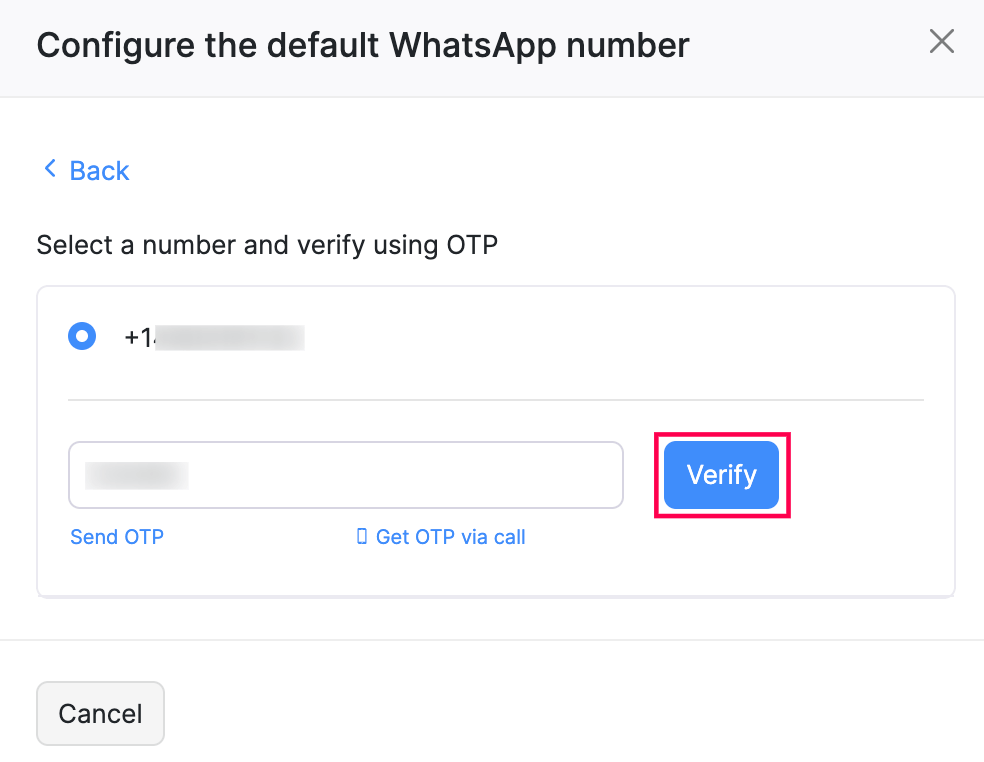
- Enter the OTP and click Verify.
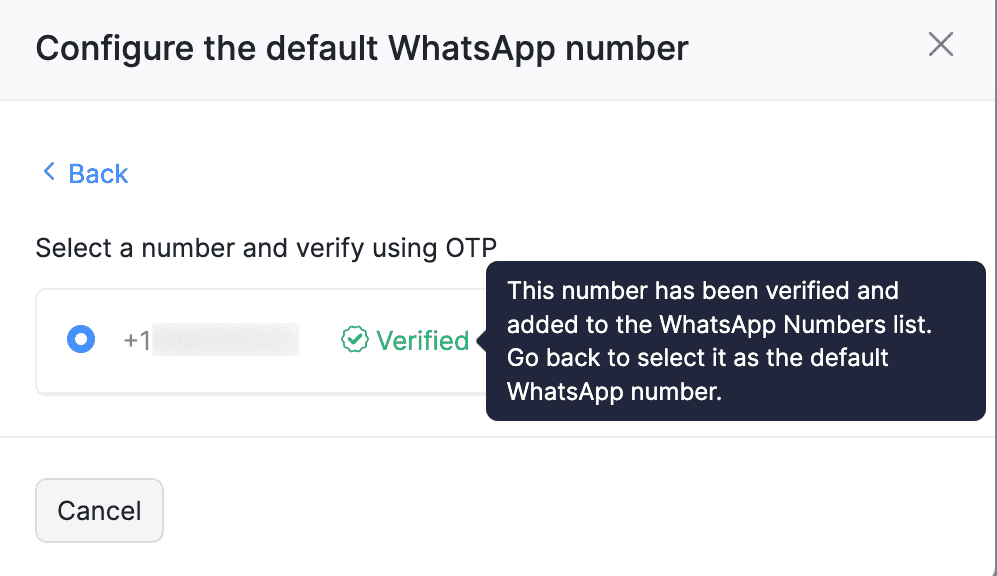
- Once verified, click Back and select the number from the Default WhatsApp Number dropdown.
Your default WhatsApp number will be updated.




